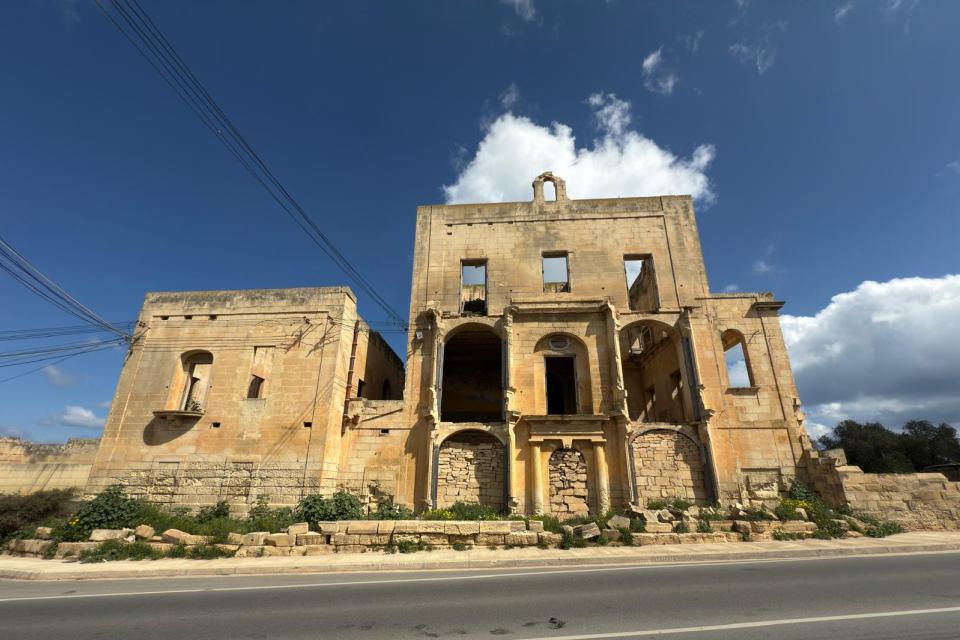
A planning application to turn what is reputed to be Malta’s most haunted house into an elderly home has been suspended at the request of the project’s architect after the Superintendence of Cultural Heritage requested amendments to the plans.
Villa Sans Souci, which is situated along Triq iz-Zejtun in Marsaxlokk, is a palazzo constructed in the 1870s which has been abandoned for several years and which is said to be haunted.
It was the subject of a planning application earlier in the year, with the application seeking to restore the villa and construct a 74-room elderly care home.
Developer Daniel Zahra wants to restore the abandoned villa, remove certain buildings connected to it, and build a four-storey elderly home adjacent to the villa, with three basement levels. The villa will, if the application is approved, serve as a restaurant, wellness centre, clinic and administrative office to complement the home.
The plans show that the façade of the villa itself will be fully restored, with its balconies restored and with an extension to the villa also planned to be restored and extended in order to have the same height as the villa itself.
The elderly home would then be built right next to the villa, with its height ultimately being slightly lower than that of the villa.
However, concerns have been raised about the scale and massing of the new elderly home vis-à-vis the villa – and the Superintendence of Cultural Heritage also had concerns over some elements of the plans.
The project was suspended at the architect’s request soon after the Superintendence’s recommendations were filed.
The Superintendence described the building as one which, “within its immediate context has significant Cultural Heritage, architectural and historical value meriting preservation.”
In a preliminary assessment on the project, the Superintendence recommended that no additions in volume should be made to the extension which adjoins the villa. The plans currently envision this extension being increased in height to match the villa – but the Superintendence wants the development “to retain the legibility and a clear distinction between the main villa and the mentioned adjoining ancillary building.”
The current plans also connect the existing – and would-be eventually restored – buildings with the newly planned elderly care home facility. The Superintendence however said that there should be a gap between the existing buildings and the proposed new building.
“This office would not be opposed to an interconnection between the existing buildings and the new one at the lower levels,” it wrote.
It also said that the proposed façade should be “better articulated, introducing vertical punctuating elements, visually dividing the facade into four bays, so that the architectural rhythm is more in harmony with that of the existing villa’s façade, thus resulting in a more coherent design.”
The Superintendence also said that an ancillary building to the villa which the developer initially intended to demolish should be retained, while the villa’s back terrace’s formal passages which lead to a valley close and a semicircular nymphaeum should also be retained.
As for proposed additions towards the back of the proposed building, the Superintendence said that “any additions are not to interfere with the existing topography of the terraced fields” and that the proposal should be amended “to follow the already existing divisions of land parcels” that are recorded in historical survey sheets.
Finally, the Superintendence said that “the existing historic passageway running longitudinally across the whole site [which included a considerable ODZ area behind the currently existing villa] is to be preserved in its totality, retaining its legibility.”
The Superintendence said that the recommendations are based on a preliminary assessment due to most of the site not being accessible at the time that their inspection was carried out. It said that there may be requests for further amendments when updated plans are submitted.
Local council supports villa restoration, but seeks changes to design
In a submission on the project, the Marsaxlokk Local Council meanwhile welcomed the proposed restoration of the villa and its repurposing.
“The Marsaxlokk Local Council highlights that a home care for the elderly has become a necessity in the locality and the need will continue to grow as the population is expected to age,” the council said as it welcomed the intention to incorporate an elderly home into the project.
“Nevertheless, any development shall respect the original architecture of the main building and any new buildings shall, as much as possible, blend with the surroundings,” the council said.
It said that the original villa façade should be restored to its original form – something the project includes and something that the council welcomed.
The council said that the façade of the new building housing the elderly home should be built using limestone, and said that the design of the new façade should improve to “incorporate architectural features inspired by the original Villa Sans Souci.”
Finally, the council said that the “proposed creation of new blank walls” on the end of the proposed new building should be replaced with a terraced design so to improve the view of the new building along Triq iz-Zejtun.
The NGO Din L-Art Ħelwa meanwhile objected to the project, saying that the new take-up of ODZ land and the “massive volume” of the new development would “overwhelm the historical property.”
From chief residence, to brothel, to a haunted legend
Villa Sans Souci was built around the 1870s by Professor Salvatore Luigi Pisani, who at the time was the Chief Government Medical Officer – incidentally Malta’s first such officer.
The Superintendence of Cultural Heritage highlighted in its assessment that Pisani’s good friend and artist Lazzaro Pisani had done a mural on the wall opposing the staircase on its first floor and other wall paintings with floral motifs.
The main façade also has a bell cot standing out: it is speculated that this was likely intended for emergency communication purposes before telephones were introduced in the Maltese islands.
Prof Pisani lived in the villa for 13 years before he passed away at the age of 80 over there on 27 October 1908. The property passed down to his heirs and it was used as their country/summer residence before being used as a small guest house in the 1930s.
The family sold the property in 1940 and it became accommodation for the British Air Force and Naval Division.
It is later said to have been used as a brothel before being abandoned.
This is perhaps why the building garners its mysterious reputation as a haunted house: there are no murders or similarly grizzly events documents at the villa, but the moniker that the house held an unruly spiritual presence may have been something conjured up to keep people away from it while it served as a brothel.
Still, some who have entered the site have said that a constant feeling of “dread” and “paranoia” follows their every step.
The building has long been abandoned: a 2005 planning application to convert the villa into a five-star hotel was withdrawn, and it has laid untouched since.












